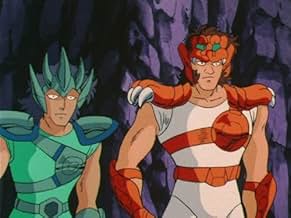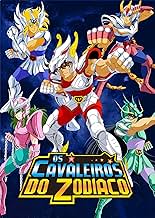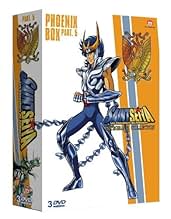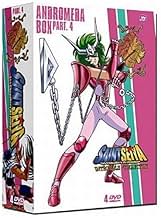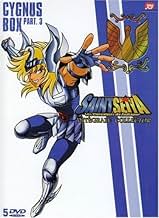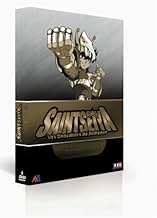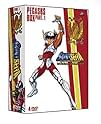IMDb-BEWERTUNG
8,4/10
11.952
IHRE BEWERTUNG
Eine Gruppe junger Krieger, die als "Heilige" bekannt sind, jeder im Besitz eines "Tuchs", das von einer anderen Konstellation bewacht wird, muss die Reinkarnation der Göttin Athene schützen... Alles lesenEine Gruppe junger Krieger, die als "Heilige" bekannt sind, jeder im Besitz eines "Tuchs", das von einer anderen Konstellation bewacht wird, muss die Reinkarnation der Göttin Athene schützen.Eine Gruppe junger Krieger, die als "Heilige" bekannt sind, jeder im Besitz eines "Tuchs", das von einer anderen Konstellation bewacht wird, muss die Reinkarnation der Göttin Athene schützen.
Folgen durchsuchen
Empfohlene Bewertungen
There'll never be enough space to describe how special this series really is here, but maybe it can't be said with words as it is. Saint Seiya is very much a visual experience, after all.
The story, in a nutshell, is about five young boys who's task it is to defend the modern-day reincarnation of Athena against several threats. This translates into loads of very theatrical duels between these five Bronze Saints and their rivals, who happen to all be pretty boys with groovy armors and hairstyles. At a glance, it sounds terribly daft, but there's so much -more- in here than in your average boys-oriented battle series.
For starters, the overall quality of the presentation is quite a surprise. Of course, for such a long TV series there are always one or two episodes that look a bit drab. But taking in the big picture, Saint Seiya has an immediately recogniseable visual style of it's own that really leaves an impression. Long, fluttering strands of hair (in some very groovy colors) surround faces with dreamy eyes, and the fine, stylised bodies of the characters are shot from many inventive angles and animated with lots of flair. Kudos also to the one behind the backdrops; Saint Seiya sports some of the most gorgeous background paintings I've ever seen. From ruins of Greek temples to snowy wastelands, every setting is painted with rich and exquisite detail.
The music would really deserve a full review of it's own, as composer Seiji Yokoyama has done a marvellous job. Rousing, dramatic themes are the order of the day, who fit the scenes wonderfully and amplify the impact of the series no end. They also stick in your head forever, as do the punchy rock songs in the opening credits (it's the music that drew me into this series to begin with, actually. One listen of "Soldier Dream" and you're marked for life).
The plots and structure of the battles have their own "typically Saint Seiya" style as well. What is remarkable is how much cruelty and sadness shows through here. Not just meaning that the fights get rather bloody at some points (Hyoga's duel against Milo of Scorpio), but also that a lot of the characters have painful pasts and deep traumas. This makes for a rich, and very interesting cast. The opponents of our heroes aren't plain "nasties", they usually have their own ways of thinking which pushes them to fight for their cause. They're often misguided, or being used for someone's other dark means, which makes it all the more tragic to see them bravely dying in a battle to the limits, after they've shown such rich and fascinating personalities. There are only one or two truly "evil" characters among the enemies (and even they are very captivating to watch).
The five young heroes have equally likeable and deep personalities (with the exception of mister big hero Seiya, perhaps), and develop distinct styles of thinking and of fighting throughout the series. It makes for a gripping experience, full of rich and very dramatic moments.
Another interesting touch is the clever use of mythologic references. Each character is affiliated to a constellation, and often to a mythological figure as well. These are usually well-researched and very clever references, and it's probably the best job I've ever seen of bringing ancient myths up to date again, all while respecting the tone of the original myth.
With such a long series (114 episodes), there are ups and downs, inevitably. Particularly during the first "Sanctuary" series, Toei larded on a big dose of filler episodes and soulless extra characters, purely for marketing purposes, who just hamper the series as a whole. The later "Poseidon" episodes are also rather dull and empty. The best of the series is concentrated in the latter Sanctuary episodes, and the tremendous Asgard series. Next to the TV series, there are also 4 short movies, worth watching just for the eye candy (the Abel movie is really wonderful to look at).
All in all, Saint Seiya is and always will be one of the greatest works Japan has produced. It has gathered a huge lot of very faithful fans, simply because once you've gotten into the flavor of Saint Seiya, you'll never be able to forget it again. Some may be put off by it's delicate visual style and baroque touches, but this was never intended for those who can't appreciate beautiful stories in the first place. Just a shame this is hardly known on the English-language market.
The story, in a nutshell, is about five young boys who's task it is to defend the modern-day reincarnation of Athena against several threats. This translates into loads of very theatrical duels between these five Bronze Saints and their rivals, who happen to all be pretty boys with groovy armors and hairstyles. At a glance, it sounds terribly daft, but there's so much -more- in here than in your average boys-oriented battle series.
For starters, the overall quality of the presentation is quite a surprise. Of course, for such a long TV series there are always one or two episodes that look a bit drab. But taking in the big picture, Saint Seiya has an immediately recogniseable visual style of it's own that really leaves an impression. Long, fluttering strands of hair (in some very groovy colors) surround faces with dreamy eyes, and the fine, stylised bodies of the characters are shot from many inventive angles and animated with lots of flair. Kudos also to the one behind the backdrops; Saint Seiya sports some of the most gorgeous background paintings I've ever seen. From ruins of Greek temples to snowy wastelands, every setting is painted with rich and exquisite detail.
The music would really deserve a full review of it's own, as composer Seiji Yokoyama has done a marvellous job. Rousing, dramatic themes are the order of the day, who fit the scenes wonderfully and amplify the impact of the series no end. They also stick in your head forever, as do the punchy rock songs in the opening credits (it's the music that drew me into this series to begin with, actually. One listen of "Soldier Dream" and you're marked for life).
The plots and structure of the battles have their own "typically Saint Seiya" style as well. What is remarkable is how much cruelty and sadness shows through here. Not just meaning that the fights get rather bloody at some points (Hyoga's duel against Milo of Scorpio), but also that a lot of the characters have painful pasts and deep traumas. This makes for a rich, and very interesting cast. The opponents of our heroes aren't plain "nasties", they usually have their own ways of thinking which pushes them to fight for their cause. They're often misguided, or being used for someone's other dark means, which makes it all the more tragic to see them bravely dying in a battle to the limits, after they've shown such rich and fascinating personalities. There are only one or two truly "evil" characters among the enemies (and even they are very captivating to watch).
The five young heroes have equally likeable and deep personalities (with the exception of mister big hero Seiya, perhaps), and develop distinct styles of thinking and of fighting throughout the series. It makes for a gripping experience, full of rich and very dramatic moments.
Another interesting touch is the clever use of mythologic references. Each character is affiliated to a constellation, and often to a mythological figure as well. These are usually well-researched and very clever references, and it's probably the best job I've ever seen of bringing ancient myths up to date again, all while respecting the tone of the original myth.
With such a long series (114 episodes), there are ups and downs, inevitably. Particularly during the first "Sanctuary" series, Toei larded on a big dose of filler episodes and soulless extra characters, purely for marketing purposes, who just hamper the series as a whole. The later "Poseidon" episodes are also rather dull and empty. The best of the series is concentrated in the latter Sanctuary episodes, and the tremendous Asgard series. Next to the TV series, there are also 4 short movies, worth watching just for the eye candy (the Abel movie is really wonderful to look at).
All in all, Saint Seiya is and always will be one of the greatest works Japan has produced. It has gathered a huge lot of very faithful fans, simply because once you've gotten into the flavor of Saint Seiya, you'll never be able to forget it again. Some may be put off by it's delicate visual style and baroque touches, but this was never intended for those who can't appreciate beautiful stories in the first place. Just a shame this is hardly known on the English-language market.
This is one of the greatest animes ever made. I grew up watching the show, hell I still do watch it when ever I can find it on tv.
Saint Seiya is a Japanese animation TV series about a group of young men chosen to defend the Goddess Athena with their mysterious powers. However, it isn't simply an action series where everyone gets beaten to pulp. It is scattered with mythological references, from Greek mythology to Norse tales. The graphics, although rather old (1986) are splendid, very aesthetical. We quickly become attached to all five of the heroes, who will risk their lives to preserve justice and peace. The musical score of the anime is, all along, a work of art. All in all, anyone interested in mythology and who likes Japanes animation should try to get his hands on this deep yet action filled anime!
Saint Seiya "The Knights of the Zodiac" is a cult anime that marked an entire generation of fans, which had enormous success worldwide at the turn of the 80s and early 90s.
The animated series, produced by Toei Animation in 1986, is based on the famous manga of the same name by Masami Kurumada, and tells the adventures of a group of young warriors, the knights of Athena, who fight to protect the goddess and the Earth. The story of the anime is fascinating and has several elements of Greek and Nordic mythology and religions including Buddhism, Shintoism, etc.
The characterization of the many characters is one of the anime's strong points.
The knights (saint) designed and created by Masami Kurumada are all beautifully characterized, with strong and distinct personalities, which make them unique, and many of them are memorable characters.
The main characters are: Seiya of Pegasus, the protagonist, a good, impulsive and courageous boy who never gives up in the face of countless difficulties; Shiryu of the Dragon, a stoic and wise warrior, who fights for others; Hyoga of the Swan, a cold boy, who however hides a great pain in his heart; Shun of Andromeda, a kind and compassionate boy, who sacrifices himself for others; Ikki from Phoenix, a strong, rebellious and lonely boy, who hides a dark and sad past; Saori, a girl, reincarnation of Athena in the 20th century, torn between her human feelings and her duties as a goddess who protects humanity.
And then there are several secondary characters, including silver knights, golden knights, warriors of Asgard and marine generals, some of whom are wonderful antagonists both in terms of visuals and characterization.
Shingo Araki's character design is another very positive element of the anime, an effective, beautiful and very suitable design, which makes the anime immediately recognizable, which stands out from the mass of anime.
The armor of the knights and enemies are a real spectacle, with their bright colors and fascinating details. Some of the armor designs created by Masami Kurumada are amazing ideas.
The music of the anime is another memorable element, a pleasure for the ears. The background music is epic and engaging, and helps to create a very evocative atmosphere.
Another honorable mention are some duels present in the anime, unforgettable and of great charm.
In conclusion, "The Knights of the Zodiac" is an anime of great quality, obviously we must and must contextualize it in the period in which it was released, that is, in the mid-80s: contextualized in that period, it is one of the best anime ever of the late 80s, a true cult, which has managed to conquer audiences of all ages. The series is a true jewel of 80s Japanese animation that conquered the whole world of that period, and which in Italy (and not only) has remained unforgettable.
Rating: 10. I give it the best, because it is an absolute cult anime of the animation of the late 80s and early 90s.
The animated series, produced by Toei Animation in 1986, is based on the famous manga of the same name by Masami Kurumada, and tells the adventures of a group of young warriors, the knights of Athena, who fight to protect the goddess and the Earth. The story of the anime is fascinating and has several elements of Greek and Nordic mythology and religions including Buddhism, Shintoism, etc.
The characterization of the many characters is one of the anime's strong points.
The knights (saint) designed and created by Masami Kurumada are all beautifully characterized, with strong and distinct personalities, which make them unique, and many of them are memorable characters.
The main characters are: Seiya of Pegasus, the protagonist, a good, impulsive and courageous boy who never gives up in the face of countless difficulties; Shiryu of the Dragon, a stoic and wise warrior, who fights for others; Hyoga of the Swan, a cold boy, who however hides a great pain in his heart; Shun of Andromeda, a kind and compassionate boy, who sacrifices himself for others; Ikki from Phoenix, a strong, rebellious and lonely boy, who hides a dark and sad past; Saori, a girl, reincarnation of Athena in the 20th century, torn between her human feelings and her duties as a goddess who protects humanity.
And then there are several secondary characters, including silver knights, golden knights, warriors of Asgard and marine generals, some of whom are wonderful antagonists both in terms of visuals and characterization.
Shingo Araki's character design is another very positive element of the anime, an effective, beautiful and very suitable design, which makes the anime immediately recognizable, which stands out from the mass of anime.
The armor of the knights and enemies are a real spectacle, with their bright colors and fascinating details. Some of the armor designs created by Masami Kurumada are amazing ideas.
The music of the anime is another memorable element, a pleasure for the ears. The background music is epic and engaging, and helps to create a very evocative atmosphere.
Another honorable mention are some duels present in the anime, unforgettable and of great charm.
In conclusion, "The Knights of the Zodiac" is an anime of great quality, obviously we must and must contextualize it in the period in which it was released, that is, in the mid-80s: contextualized in that period, it is one of the best anime ever of the late 80s, a true cult, which has managed to conquer audiences of all ages. The series is a true jewel of 80s Japanese animation that conquered the whole world of that period, and which in Italy (and not only) has remained unforgettable.
Rating: 10. I give it the best, because it is an absolute cult anime of the animation of the late 80s and early 90s.
10ShiryuK
Saint Seiya, no doubt, is the best Anime Japan has to offer. It is fast, exciting, and moving. The story line and the character are so real and deep that you'll be attached to them right away. The fierce and fast action is spetacular even using today's standards. But you really have to know the series first in order to enjoy more from the movie. The movie itself, for a first timer is still great, but there are missing details, which by knowing the series will help to fill them.
Great anime, watch it.
Great anime, watch it.
Wusstest du schon
- WissenswertesAlthough it's never mentioned in the anime, the manga readers know that Mitsumasa Kido has fathered the 100 so-called 'orphans' that he later pretends to foster before training and sending them all over the globe to earn Armors and become Saints. The Bronze Saints are all half-brothers with the exception of Shun and Ikki who have the same mother.
- Alternative VersionenIn Spain and other countries of Latin America, the original release in the '90s had a different intro, with scenes from the movie "Abel" and a song in Spanish (which wasn't a translation of an original but instead a translation of the French intro from "Les Chevaliers du Zodiaque").
- VerbindungenFeatured in Club Dorothée: Folge vom 22. März 1989 (1989)
- SoundtracksEien Blue
(First Ending song)
Music by Hiroaki Matsuzawa, Yôgo Kôno & Nobuo Yamada (as NoB)
Lyrics by Machiko Ryuu
Performed by NoB and The Make-Up
Top-Auswahl
Melde dich zum Bewerten an und greife auf die Watchlist für personalisierte Empfehlungen zu.
Details
- Erscheinungsdatum
- Herkunftsland
- Sprachen
- Auch bekannt als
- Knights of the Zodiac
- Drehorte
- Tokio, Japan(Studio)
- Produktionsfirmen
- Weitere beteiligte Unternehmen bei IMDbPro anzeigen
Zu dieser Seite beitragen
Bearbeitung vorschlagen oder fehlenden Inhalt hinzufügen

Oberste Lücke
What is the Canadian French language plot outline for Saint Seiya: Die Krieger des Zodiac (1986)?
Antwort



